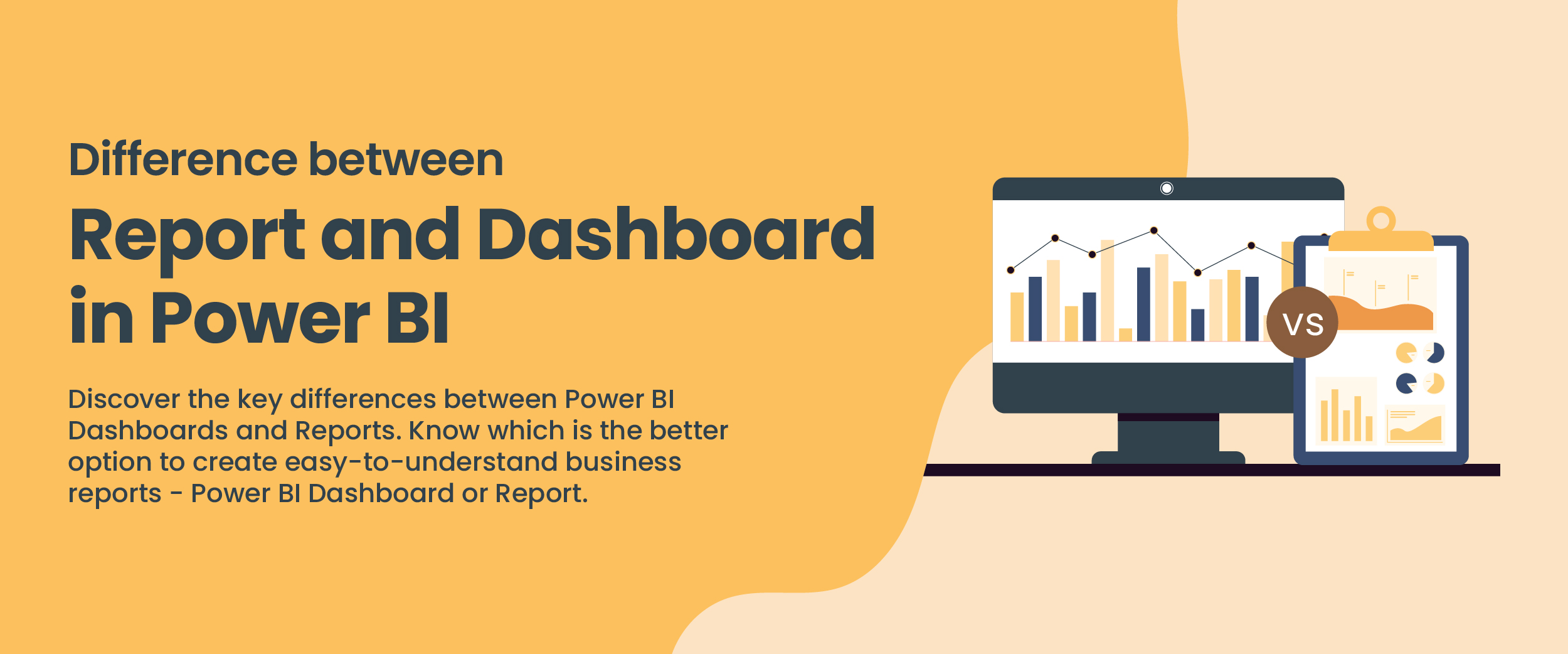Top Differences Between Reports and Dashboards in Power BI
Power BI is a sophisticated business intelligence application developed by Microsoft that enables users to analyze and display data. It comprises two main components for data presentation: reports and dashboards. While both reports and dashboards serve the objective of delivering data insights, they have various qualities and functions.
Understanding the difference between reports and dashboards in Power BI is essential for efficiently using this tool and providing the relevant information to the appropriate audience. In this article, we will examine this distinction between reports and dashboards in Power BI and cover recommended practices for constructing them.
Reports in Power BI: A Brief Overview
A report in Power BI is a compilation of visualizations, tables, and charts that display data in an organized and structured manner. It gives a comprehensive picture of the data, enabling users to scrutinize and evaluate information from numerous viewpoints. Reports operate as a means of data exploration, enabling users to go deep into the details and unearth useful insights. The main goal of reports in Power BI is to enhance data analysis and decision-making.
Dashboards in Power BI: A Brief Overview
A dashboard in Power BI is a single-page canvas that provides critical metrics, visualizations, and insights in a simple and aesthetically attractive manner. It provides a high-level summary of data, presenting information in a style that is simple to comprehend and analyze at a glance. Dashboards are intended to offer swift insights and enable users to monitor the success of their company or project in real-time. The primary goal of dashboards in Power BI is to give a rapid and simplified view of vital information. To learn more about reports and dashboards in Power BI, you can opt for this detailed Power BI course.
The Key Differences Between Reports and Dashboards in Power BI
The following are the key differences between reports and dashboards.
1. Focus on Data Exploration vs. Data Visualization
The fundamental difference between reports and dashboards in Power BI lies in their emphasis. Reports are primarily targeted at data exploration. They supply consumers with the capacity to plunge into the details, scrutinize data from numerous aspects, and unearth insights. They give a complete picture of the data, enabling users to undertake in-depth investigations and generate custom computations.
On the other side, dashboards emphasize data visualization. They present a summary picture of key metrics and trends, delivering a high-level overview of the data. They are intended to offer swift insights and enable users to monitor the success of their company or project at a glance.
2. Interactivity and Customization Options
Reports in Power BI provide considerable interactivity and customization possibilities. Users may interact with the graphics, apply filters, delve down into individual data points, and construct custom computations. They enable latitude in terms of analyzing and interpreting the data according to individual preferences.
On the other hand, dashboards offer limited interaction. While users may apply basic filters and delve down to some level, the emphasis is on delivering preset insights and data in a visually appealing manner. They are intended for rapid access to key information without the ability to substantially alter or interact with the aesthetics.
3. Level of Detail and Granularity
Reports enable users to evaluate data at a granular level, offering extensive information and facilitating in-depth research. Users may investigate and analyze data points, apply filters, and display information at multiple degrees of detail. Reports enable the freedom to hone in on certain areas of the data and undertake extensive analysis.
In contrast, dashboards offer a high-level view of the data. They concentrate on essential statistics, trends, and summaries rather than presenting profound information. Dashboards offer information in a simplified manner, providing an overview without the opportunity to go deep into the underlying data.
4. Access and Sharing Capabilities
Reports and dashboards differ in terms of access and sharing capabilities. Reports may be shared with others, enabling them to engage with the data and discover insights. Users may communicate, issue remarks, and share reports with stakeholders. Reports may also be set for automatic refreshes to guarantee that the data remains up-to-date.
Dashboards are designed for sharing and collaboration. Users may share dashboards with stakeholders, providing them with a consistent view of the data without the ability to alter the information. Dashboards facilitate real-time monitoring and sharing of critical data and insights, making them suitable for executive-level reporting and monitoring requirements.
The table given below will help you understand the comparison easily.
| Feature | Report | Dashboard |
| Purpose | Provides detailed data analysis and insights with interactive visuals. | Offers a high-level overview of key metrics and KPIs in a consolidated view. |
| Layout | Typically consists of multiple pages or tabs with various visuals, tables, and charts. | Single-page canvas with limited space for visuals and focus on data summaries. |
| Interactivity | Users can interact with visuals, apply filters, drill down, and explore data at a granular level. | Limited interactivity, with predefined filters and limited drill-down capabilities. |
| Data Complexity | Can handle complex data models with multiple tables and relationships. | Generally relies on simpler data structures and pre-aggregated data for faster performance. |
| Data Exploration | Allows users to create ad-hoc analysis, ask questions using natural language queries, and explore data in-depth. | Primarily provides a snapshot of predefined metrics and KPIs without extensive exploration options. |
| Collaboration | Suitable for collaborative analysis and sharing insights with colleagues or teams. | Facilitates quick sharing and distribution of summarized information to a wider audience. |
| Report Publishing | Can be published to the Power BI service, shared with specific users or groups, and scheduled for automatic data refresh. | Individual visuals from the dashboard can be pinned and published to a dashboard, which can then be shared. |
| Mobile Experience | Offers responsive design and optimized viewing experience on mobile devices using Power BI mobile app. | Dashboards are specifically designed for mobile devices, providing a condensed view of essential metrics. |
| Real-Time Data | Supports real-time data analysis with live connections or scheduled refreshes. | Displays data that updates periodically, based on predefined refresh intervals. |
| Customization | Provides extensive customization options for visuals, formatting, and report layout. | Limited customization options for visuals and overall layout, with a focus on predefined arrangements. |
Get a confirmed ₹35,000 total stipend on your first internship with our data science placement guarantee courses.
Factors to Consider while Choosing Between Reports and Dashboards
When choosing between a report and a dashboard in Power BI, the following criteria should be considered:
- Objective and Audience: Determine the particular objective of the analysis and define the target audience. Reports are more optimal for in-depth research and data exploration, whereas dashboards are designed for high-level monitoring and swift insights.
- Quantity of Detail: Consider the amount of detail necessary for the analysis. Reports provide for extensive analysis and comprehensive inspection of data points, whereas dashboards offer a simplified picture with less granularity.
- Interaction Needs: Assess the necessity for interaction and customization choices. Reports include substantial interactivity, enabling users to apply filters, dive down, and do computations. Dashboards provide little interaction but deliver predetermined insights and information.
- Time Sensitivity: Determine the urgency and timeliness of the material. Dashboards deliver real-time or near-real-time updates, making them useful for monitoring time-sensitive data. Reports may have scheduled revisions or need human modifications.
Design Guidelines for Reports
Follow these guidelines while designing reports in Power BI.
- Keep the Layout Orderly and Organized: Ensure that the report layout is logical and simple to investigate, with a clear flow of information.
- Use Pertinent Visuals: Select visualizations that effectively convey the desired message and insights. Choose images that effectively portray the facts and make them simple to comprehend.
- Apply Consistent Formatting and Color Schemes: Maintain visual coherence by employing uniform formatting, font styles, and color schemes across the report. This gives a professional and cohesive design.
- Offer Appropriate Titles, Labels, and Descriptions: Clearly designate each visualization with descriptive names and offer pertinent labels and descriptions to promote comprehension and context.
Design Guidelines for Dashboards
Follow these guidelines while designing dashboards in Power BI.
- Focus On Essential Metrics: Identify and highlight the most significant indicators and KPIs on the dashboard. Keep the interface basic and avoid overwhelming it with extra information.
- Use Visually Engaging Graphics: Utilize aesthetically appealing charts, graphs, and images to capture attention and deliver information efficiently. Choose graphics that are simple to comprehend and visually captivating.
- Arrange Visuals Logically: Organize the visuals on the interface in a logical manner. Group related graphics together and guarantee a logical flow of information.
- Utilize Filters and Slicers: Incorporate filters and slicers to enable users to modify the display and interact with the data on the interface. This enhances the user experience.


Tips for Effective Data Presentation
Keep the following tips in mind to effectively present your data.
- Use Pertinent and Succinct Titles: Provide concise and informative names for each visualization to swiftly express its purpose and significance.
- Avoid Cluttering Graphics: Avoid cluttering visuals with numerous data points or superfluous features. Keep the images orderly and focused on vital information.
- Provide Contextual Information: Include contextual information and explanations when appropriate to assist people in comprehending the data and its consequences
- Regularly Review and Update: Regularly review and update reports and dashboards to ensure they remain pertinent and accurate. Consider altering business demands and data enhancements.
Conclusion
In summary, reports and dashboards play crucial roles within the Power BI ecosystem. Reports are comprehensive documents that present detailed research and analysis, offering a thorough examination of a particular subject. On the other hand, dashboards provide a visually appealing and succinct overview of critical information. Gaining a comprehensive understanding of the difference between reports and dashboards in Power BI is crucial for effectively harnessing the platform’s capabilities and delivering pertinent insights to the relevant stakeholders.







